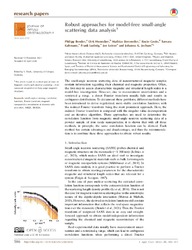Robust approaches for model‐free small‐angle scattering data analysis
Bender, Philipp
Honecker, Dirk
Bersweiler, Mathias
Costo, Rocio
Kahmann, Tamara
Ludwig, Frank
Leiner, Jon
Jochum, Johanna K.
DOI: https://doi.org/10.1107/S1600576722004356
Persistent URL: http://resolver.sub.uni-goettingen.de/purl?gldocs-11858/10220
Persistent URL: http://resolver.sub.uni-goettingen.de/purl?gldocs-11858/10220
Bender, Philipp; Honecker, Dirk; Bersweiler, Mathias; Costo, Rocio; Kahmann, Tamara; Ludwig, Frank; Leiner, Jon; Jochum, Johanna K., 2022: Robust approaches for model‐free small‐angle scattering data analysis. In: Journal of Applied Crystallography, Band 55, 3: 586 - 591, DOI: 10.1107/S1600576722004356.
 |
Dokument öffnen: |
The small‐angle neutron scattering data of nanostructured magnetic samples contain information regarding their chemical and magnetic properties. Often, the first step to access characteristic magnetic and structural length scales is a model‐free investigation. However, due to measurement uncertainties and a restricted q range, a direct Fourier transform usually fails and results in ambiguous distributions. To circumvent these problems, different methods have been introduced to derive regularized, more stable correlation functions, with the indirect Fourier transform being the most prominent approach. Here, the indirect Fourier transform is compared with the singular value decomposition and an iterative algorithm. These approaches are used to determine the correlation function from magnetic small‐angle neutron scattering data of a powder sample of iron oxide nanoparticles; it is shown that with all three methods, in principle, the same correlation function can be derived. Each method has certain advantages and disadvantages, and thus the recommendation is to combine these three approaches to obtain robust results. Three different approaches are compared for determination of the correlation function from the small‐angle neutron scattering data of a powder sample of iron oxide nanoparticles.
Statistik:
ZugriffsstatistikSammlung:
Schlagworte:
small‐angle scatteringcorrelation functions
Fourier transform
magnetic nanoparticles
modulation of intensity with zero effort
MIEZE
RESEDA
This is an open access article under the terms of the Creative Commons Attribution License, which permits use, distribution and reproduction in any medium, provided the original work is properly cited.

